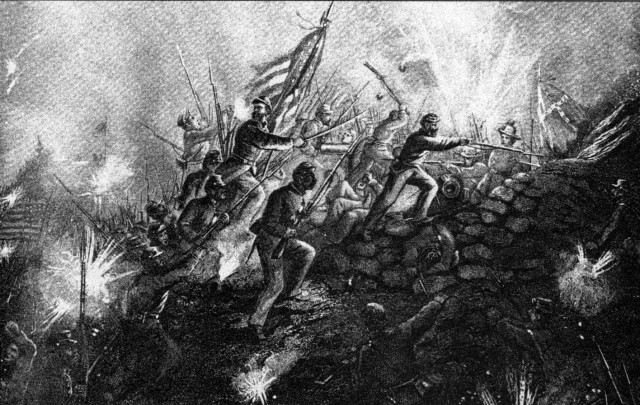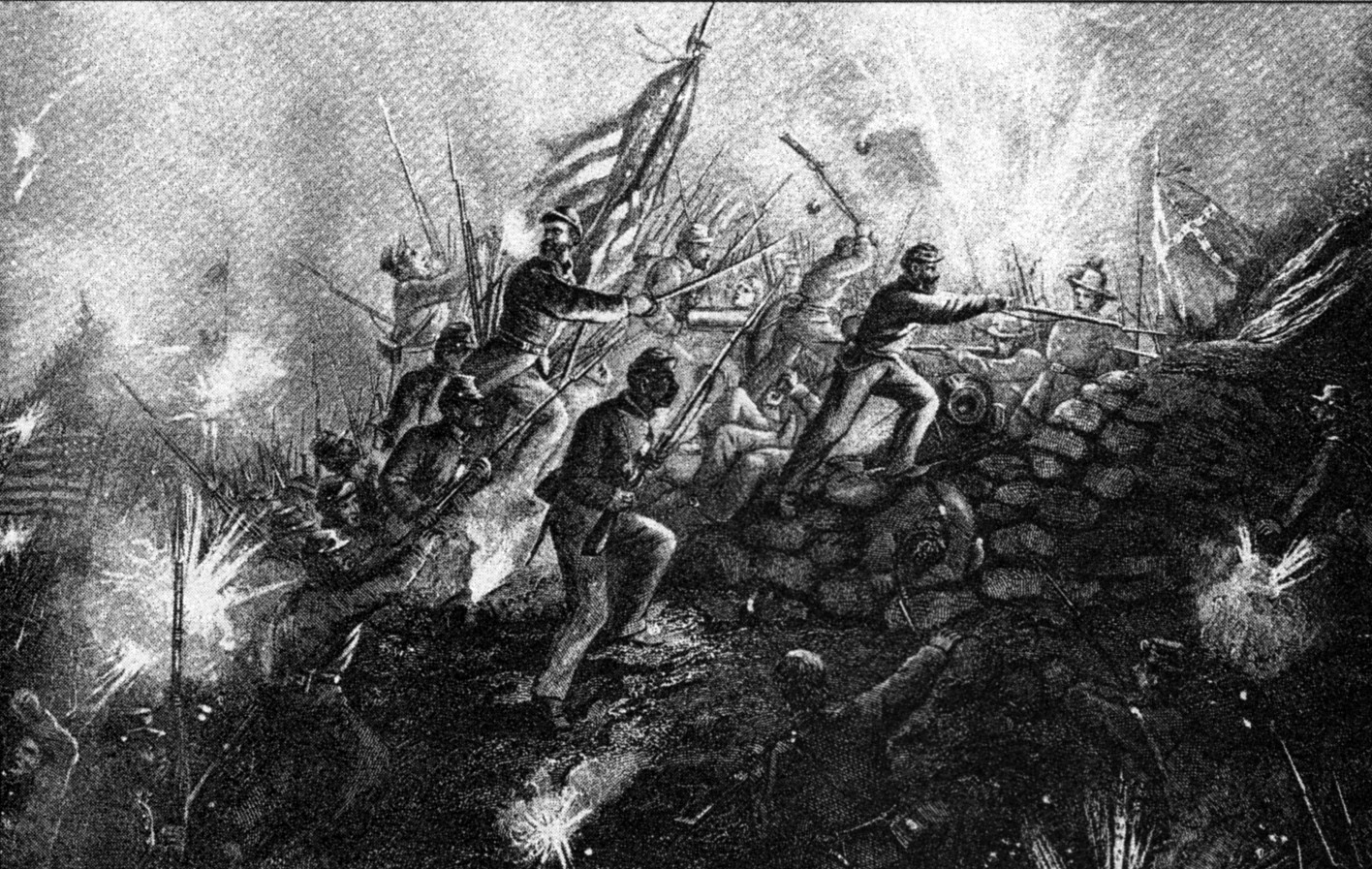From the beginning of the Civil War, abolitionists in the North had urged President Abraham Lincoln to outlaw slavery and authorize the organization of regiments of black soldiers.
Blacks were already serving the Army in a variety of support roles. Men of African descent had also contributed in America's previous wars, it was argued, and there was no reason to keep them on the sidelines in this one - particularly when it was their freedom at stake.
But Lincoln, in a futile attempt to placate the southern states after his election, had promised not to interfere with slavery. Even after Confederate batteries fired on Fort Sumter at Charleston, S.C., Lincoln proposed to wage war only to preserve the Union.
He held to that line for almost two years. But the cry of abolition grew louder, and England and France appeared to be leaning toward recognizing Confederate independence. Wily politician that he was, Lincoln knew they would never recognize a nation fighting to keep slavery, so immediately following the Union victory at Antitiem, Md., in September 1862 he issued the Emancipation Proclamation.
Gov. John Andrew of Massachusetts was among the antislavery crusaders who had pressured Lincoln to raise black units. Armed with the Emancipation Proclamation, he convinced Secretary of War Edwin Stanton to allow him to raise units including "persons of African descent."
Acting before Stanton could change his mind, Andrew authorized the North's first regiment of black troops, the 54th Massachusetts Volunteer Infantry. To command his new regiment, Andrew chose 25-year-old Robert Gould Shaw, the son of wealthy Boston abolitionists.
Opponents of the idea of a black regiment tried to intimidate recruits and threatened whites involved in the recruiting campaign. The Boston Pilot wrote scornfully "one Southern regiment of white men would put 20 regiments of them Negroes to flight in an hour." But the Army and Navy Journal reminded the naysayers "from the beginning to the conclusion of the War of Revolution, negroes served in the Continental armies with intelligence, courage and steadfastness; and that important results in several instances are traceable to their good conduct."
Recruiting efforts spread on to New York, Pennsylvania, the Midwest, Canada, as well as in Massachusetts. In late March, 900 men were in training in Readville, Mass. By May so many Negroes had applied that Andrew authorized a second black regiment, the 55th Mass.
Among the early recruits for the 54th were Lewis Douglass, eldest son of abolitionist leader Frederick Douglass and a former seminary student named William Carney. Another of Douglass' sons joined later, and Lewis was named sergeant major of the regiment.
On May 18, 1863, Shaw received orders from the War Department: "The 54th Massachusetts will report to General [David] Hunter. Make requests so that they may go through at once." Ten days later, Shaw said goodbye to his wife for four weeks and led his regiment on a triumphal march through the streets of Boston to begin the voyage to Hilton Head, S.C.
Americans widely believed that black soldiers would be worthless in a fight, but Brig. Gen. Alfred Terry wasted little time throwing the regiment into combat. At James Island, S.C., on July 16, the 54th Mass. and 10th Connecticut formed the left of the Union line, with the 10th's flank on the Stono River and its back to a swamp. If the confederates broke through between the two, they could cut off and surround the 10th Conn.
They tried. Under the weight of the attack, the 54th Mass. fell back, but gave ground slowly and allowed the 10th Conn. to get out of the trap without a single casualty. Soon the main body of Union infantry came to their support, and the Confederates withdrew. Later, Shaw received a note from Terry: "I am exceedingly pleased with the conduct of your regiment," he wrote. When Brig. Gen. Truman Seymour replaced Terry, he permanently placed the 54th Mass. with six white regiments in Brig. Gen. George C. Strong's brigade.
The action at James Island was part of Seymour's grand plan to capture Charleston, S.C. Having driven back the Confederates, he now was about to try to capture Fort Wagner on Morris Island across from Fort Sumter in Charleston harbor. One assault had already failed, but Seymour set a second attack for the evening of July 18, 1863.
Fort Wagner was one of the strongest earthworks built by either side during the war. Made of spongy palmetto logs covered with sand and protected by a moat, it was garrisoned by 1,000 men, and it mounted a dozen cannon. There was only one land approach, a narrow strip between the tidal marshes and the Atlantic Ocean. In short, Fort Wagner was all but invulnerable to an infantry assault.
As Shaw, his adjutant and Strong walked along the beach on the afternoon of he 18th, Strong offered the 54th the place of honor in the attack. "You may lead the column if you say yes. Your men, I know, are worn out, but do as you choose." Eager for the 54th to show what they could do, Shaw told the adjutant to bring the regiment forward.
As they formed for the attack, Shaw addressed his men. "I want you to prove yourselves. The eyes of thousands will look upon what you do tonight." Then he walked to the center of the line and drew his sword. "Move in quick time until within a hundred yards of the fort, then double quick and charge," he said.
When the 54th was within 200 yards of Fort Wagner, the Confederates opened fire. Men dropped at every step, but nobody hesitated or turned back. Shaw plunged across the moat and scrambled up the sandy wall of the fort. "Forward, 54th!" he called as he reached the top. Then h fell over into the fort, shot through the heart.
Before Shaw fell, none of his soldiers had fired a shot, but now they waded into the Confederates in a frenzy. Sgt. Maj. Douglass stood halfway up the slope, shouting at the survivors to press on. The color bearer fell dead. A jubilant Confederate reached out for the Stars and Stripes, but Pvt. William Carney snatched the flag and scrambled for the top, ignoring wounds in his chest and both legs. He planted the flag as a rally point and fought off all attempts to capture it.
The fight was savage and brief. Capt. Luis Emilio, one of the few surviving officers, took command and ordered a retreat. Carney picked up the flag and slid back down the slope, limping to a trench 75 yards from the wall. Along the way he was hit twice more.
In less than an hour it was over. Out of the 600 who began the attack, the 54th Mass. lost 34 men killed, 146 wounded and 93 captured. The rest of Strong's brigade suffered similarly - Union casualties totaled 1,515 - making Fort Wagner one of the costliest charges of the war. The Confederates had lost 181 men.
The next day when Confederate burial parties came out to collect the dead, they buried the white soldiers and officers in separate graves, but they dug a common trench for Shaw and his 31 enlisted men. The Confederate commander refused to return Shaw's body for burial by his family, as was done often in other cases. "I shall bury him ... with the negroes that fell with him," he said.
There were other footnotes to Fort Wagner. William Carney received the Medal of Honor - the first black soldier to be so decorated. Sixteen besides him would eventually be awarded the Medal of Honor during the Civil War. More black regiments were organized, both by the states and for the Regular Army; in time, more than 180,000 men of African descent would serve in blue.
The connection between the 54th's performance at Fort Wagner and the thousands of black men who eventually served wasn't lost on the New York Times: "If this Massachusetts Fifty-Fourth had faltered ... two hundred sand colored troops for whom it would pioneer would never have been put in the field ... But it did not falter. It named Fort Wagner such a name to the colored race as Bunker Hill has been for ninety years to white Yankees.


Social Sharing